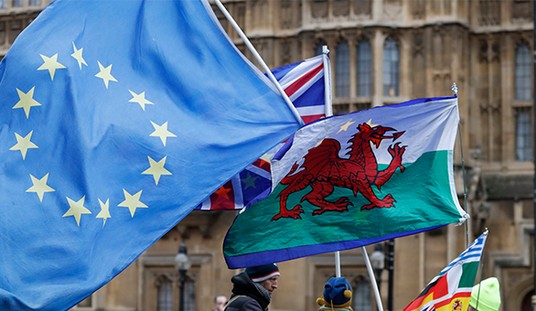At least we finally dropped under three million on this weekly metric, but that’s the only good news from the Department of Labor. Last week, 2.98 million Americans applied for jobless benefits, down from last week’s 3.169 million but still a level that would have been a record itself in pre-pandemic times. The number of benefit receivers grew by almost a half million as well, going well past 22 million and growing:
In the week ending May 9, the advance figure for seasonally adjusted initial claims was 2,981,000, a decrease of 195,000 from the previous week’s revised level. The previous week’s level was revised up by 7,000 from 3,169,000 to 3,176,000. The 4-week moving average was 3,616,500, a decrease of 564,000 from the previous week’s revised average. The previous week’s average was revised up by 7,000 from 4,173,500 to 4,180,500.
The advance seasonally adjusted insured unemployment rate was 15.7 percent for the week ending May 2, an increase of 0.3 percentage point from the previous week’s revised rate. The previous week’s rate was revised down by 0.1 from 15.5 to 15.4 percent. The advance number for seasonally adjusted insured unemployment during the week ending May 2 was 22,833,000, an increase of 456,000 from the previous week’s revised level. The previous week’s level was revised down by 270,000 from 22,647,000 to 22,377,000. The 4-week moving average was 19,760,000, an increase of 2,729,750 from the previous week’s revised average. The previous week’s average was revised down by 67,500 from 17,097,750 to 17,030,250.
As CNBC notes, that pushes the total number of claims during the shutdown to over 36 million. Not all of those remain unemployed, but clearly at least two-thirds of them do, and probably a lot more than that. The trend is slowing, but it’s not slowing enough or as much as economists expected this week:
The total 2.981 million new claims for unemployment insurance brought the coronavirus crisis total to nearly 36.5 million, by far the biggest loss in U.S. history. Last week’s count was revised up by 7,000 to 3.176 million.
Economists surveyed by Dow Jones had been expecting 2.7 million new claims. …
According to the latest figures, those displaced are still not being brought back to work under a freeze that was supposed to last weeks but now has extended for nearly two months. Continuing claims rose by 456,000 to 22.83 million, after the previous week’s total was revised down to 22.38 million.
Unlike the past couple of jobless-claims reports, this one might sour traders today on Wall Street. Futures were off by 300 points in the aftermath of the report:
Stock futures fell on Thursday after the latest jobless data underscored the coronavirus’ devastating toll on the U.S. economy.
Dow Jones Industrial Average futures fell 330 points, implying an opening loss of about 320 points. S&P 500 futures traded about 0.9% lower and Nasdaq 100 futures dipped 0.8%.
The lack of confidence might be a sign of patience wearing thin on action to shore up the economy. The CARES Act passed six weeks ago, and the Paycheck Protection Program has run through two massive tranches of cash totaling nearly $700 billion. Nothing has stopped the bleeding that the government shutdowns caused in labor markets, which means that consumer activity is going to keep going down rather than up.
On the other hand, AP analyst Christopher Rugaber finds some sunshine amidst the darkness, albeit limited:
The states that are now easing lockdowns are doing so in varied ways. Ohio has permitted warehouses, most offices, factories, and construction companies to reopen, but restaurants and bars remain closed for indoor sit-down service.
A handful of states have gone further, including Georgia, which has opened barber shops, bowling alleys, tattoo parlors and gyms. South Carolina has reopened beach hotels, and Texas has reopened shopping malls.
Data from private firms suggest that some previously laid-off workers have started to return to small businesses in those states, though the number of applications for unemployment benefits remains high.
It’s still pretty dark, though:
The job market’s collapse has occurred with dizzying speed. As recently as February, the unemployment rate was 3.5%, a half-century low. Employers had added jobs for a record 9½ years. Even in March, unemployment was just 4.4%.
Now, with few Americans shopping, traveling, eating out or otherwise spending normally, economists are projecting that the gross domestic product — the broadest gauge of economic activity — is shrinking in the April-June quarter at a roughly 40% annual rate. That would be the deepest quarterly contraction on record.
Well, that has a sunny side too, at least for the moment. The downturn in this situation was entirely artificial — caused by government literally shutting down economic activity. This didn’t come from a structural defect in the economy or a collapse of its fiscal structure, as happened in the Great Depression and in the Great Recession. The purpose for this government action was rational in trying to slow the spread of a virulent new virus, but its artificiality suggests that government can solve this by removing the restrictions it imposed.
It has to start acting quickly, however, if government wants to prevent this from becoming a structural defect or fiscal collapse. Consumers are carrying record levels of debt these days, which means that any sustained unemployment at high rates will create those problems fairly soon unless we get everyone back to work. If not, this will become a vicious cycle that could turn out to be more damaging than COVID-19 in the long run.








